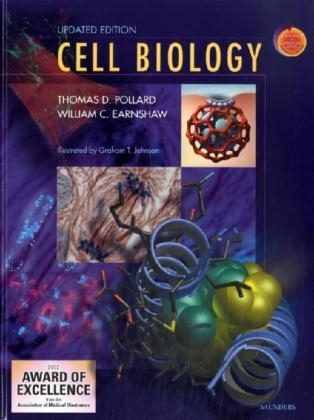
Cell Biology
Saunders
978-1-4160-2388-3 (ISBN)
- Titel erscheint in neuer Auflage
- Artikel merken
This book offers you more of what you need, less of what you don't! It is written by leading personalities in the field. Focusing on the structure and function of the cell, this radically new approach to cell biology offers a comprehensive, full-colour look at the subject and the latest developments in the field. It emphasises specific macromolecular interactions and their relation to cellular structure and function, and covers such areas as chemical building blocks, assembly, major organelles and components of the cell, cell cycle, cellular regulation, gene expression, viruses, energy interconversions, and more. It is now available as a revised reprint.
Thomas Dean Pollard is a prominent educator, cell biologist and biophysicist whose research focuses on understanding cell motility through the study of actin filaments and myosin motors. He is Sterling Professor of Molecular, Cellular & Developmental Biology and a Professor of Cell Biology and Molecular Biophysics & Biochemistry at Yale University. He was Dean of Yale's Graduate School of Arts and Sciences from 2010 to 2014, and President of the Salk Institute for Biological Studies from 1996 to 2001. Pollard is very active in promoting scientific education and research primarily through two major societies, both of which he is a past President: the American Society for Cell Biology and the Biophysical Society William Charles Earnshaw is Professor of Chromosome Dynamics at the University of Edinburgh where he has been a Wellcome Trust Principal Research Fellow since 1996. Earnshaw is an elected Fellow of the Royal Society since 2013 for his studies of mitotic chromosome structure and segregation. Before Edinburgh, he was Professor of Cell Biology and Anatomy at Johns Hopkins School of Medicine. Jennifer Lippincott-Swartz is Group Leader at the Howard Hughes Medical Institute Janelia Research Campus. Her lab uses live cell imaging approaches to analyze the spatio-temporal behaviour and dynamic interactions of molecules in cells with a special focus on neurobiology. Before Janelia, Lippincott-Swartz was a primary investigator and chief of the Section on Organelle Biology in the Cell Biology and Metabolism Branch. Her work there included a collaboration with physicists Eric Betzig and Harald Hess (now group leaders at Janelia), who proposed a new function for the photoactivatable protein. The scientists used the protein to generate photoactivatable fluorophores, or dyes, which enabled them to illuminate different sets of molecules sequentially, creating a microscope image far more detailed than previously possible. The method, called super-resolution microscopy, garnered Betzig the 2014 Nobel Prize in Chemistry.
1.General Principles of Cellular Organization BASIC CHEMICAL AND PHYSICAL CONCEPTS 2.Basic Biophysical Concepts 3.Molecular Structures 4.Macromolecular Assembly 5.Research Strategies MEMBRANE STRUCTURE AND FUNCTION 6.Membrane Structure and Dynamics 7.Membrane Pumps 8.Membrane Carriers 9.Membrane Channels 10.Membrane Physiology STORAGE AND EXPRESSION OF GENETIC INFORMATION 11.Introduction to Nuclear Structure and Function 12.Chromosome Organization 13.Packaging the DNA into Chromosomes 14.Gene Expression 15.RNA Processing 16.Information Flow Between Nucleus and Cytoplasm BIOGENESIS, TRAFFIC AND FUNCTIONS OF CELLULAR MEMBRANE SYSTEMS 17.Introduction to Membrane Compartments 18.Protein Synthesis and Folding in the Cytoplasm 19.Post-Translational Targeting of Proteins to Organelles 20.Co-Translational Import into the Endoplasmic Reticulum 21.Endoplasmic Reticulum to Golgi 22.Trans-Golgi Network and Beyond 23.Endocytosis 24.Degradation of Cellular Components RECEPTION AND TRANSDUCTION OF ENVIRONMENTAL INFORMATION 25.Signaling Overview 26.Plasma Membrane Receptors 27.Protein Hardware for Signaling 28.Second Messengers 29.Integration of Signals CELLULAR INTERACTIONS WITH NEIGHBORS AND THEIR ENVIRONMENT 30.Introduction to Cellular Adhesion and the Extracellular Matrix 31.Extracellular Matrix Molecules 32.Cellular Adhesion 33.Intercellular Junctions 34.Connective Tissues CYTOSKELETON AND CELLULAR MOTILITY 35.Overview of the Cytoskeleton and Cellular Motility 36.Actin and Actin-Binding Proteins 37.Microtubules and Microtubule-Associated Proteins 38.Intermediate Filaments 39.Motor Proteins 40.Intracellular Motility 41.Cellular Motility 42.Muscles CELL CYCLE 43.Introduction to the Cell Cycle 44.The GI Phase and Cell Cycle Regulation 45.S and DNA Replication 46.The G2 Phase 47.Mitosis and Cytokinesis 48.Meiosis 49.Programmed Cell Death
| Erscheint lt. Verlag | 26.11.2004 |
|---|---|
| Zusatzinfo | 1500 illus |
| Verlagsort | Philadelphia |
| Sprache | englisch |
| Maße | 216 x 276 mm |
| Gewicht | 2240 g |
| Themenwelt | Medizin / Pharmazie ► Medizinische Fachgebiete |
| Naturwissenschaften ► Biologie ► Zellbiologie | |
| ISBN-10 | 1-4160-2388-7 / 1416023887 |
| ISBN-13 | 978-1-4160-2388-3 / 9781416023883 |
| Zustand | Neuware |
| Haben Sie eine Frage zum Produkt? |
